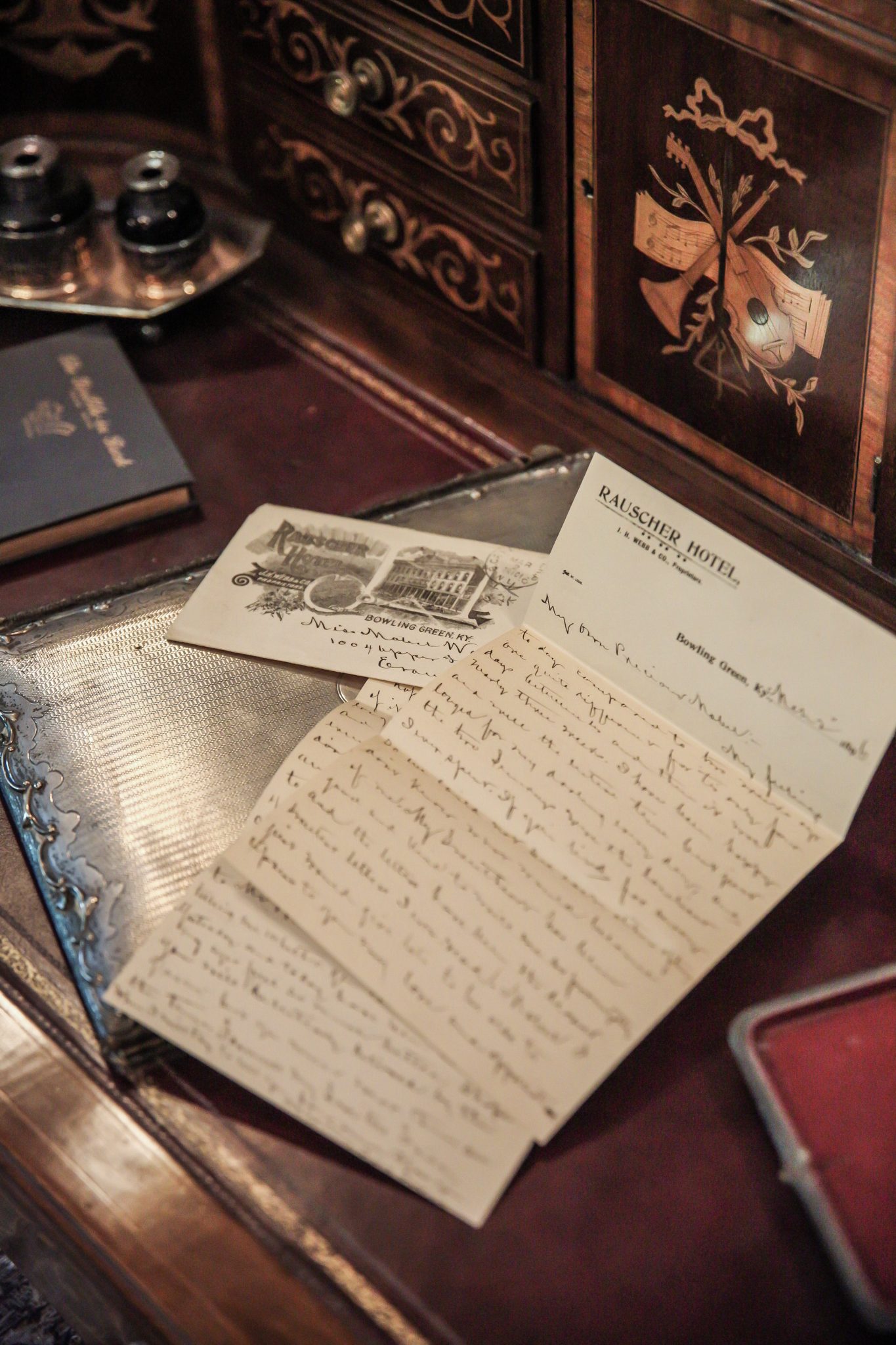In 2019, Cheekwood was gifted a shoebox full of letters that had been pulled from the closet of a relative. This find proved to be a true treasure – missives between Cheek family members dating from the 1880s to the 1950s. When the pandemic hit in 2020, Cheekwood was thrilled to receive funding from NEH to support staff members as they worked to transcribe and scan each of the 247 letters. The contents of the letters give an incredible look into the daily life of the Cheeks, from the days of Leslie and Mabel’s courtship to their lives with young children, to their shared years at Cheekwood, and to the next generation’s ownership of the estate. As part of her time as Writer-in-Residence, Cecelia Tichi has read through the letters and supplied her thoughts on their meaning.
And none will hear the postman’s knock
Without a quickening of the heart….
W. H. Auden, Night Mail, 1936
Letters posted to and from the Cheekwood estate continued a vibrant and longtime tradition of personal correspondence among the Cheek and Wood family members. To put pen to paper was de rigueur for pleasure and commitment, and the US Post Office sped the family’s first-class missives from the late 1800s and well into the twentieth century. The initial letters between Leslie Cheek and his devoted fiancée, Mabel Wood (soon to be Mrs. Cheek), broadened in due course as the family correspondence included letters of Mabel and Leslie and their children, Leslie, Jr. (b. 1908) and Huldah (b. 1915). Eventually, the family letters crossed into every region of the country and the globe, for the well-traveled Cheeks kept up correspondence at every locale, be it for duty or leisure. The Cheekwood heritage thus amplifies its grounds, gardens, and magisterial home to include a trove of correspondence, a kaleidoscope of the life and times of its founding family.
From the era of sharpened goose quills and inkpots, handwritten letters were aesthetic objects in and of themselves. For the Cheeks and their social set, it was second nature to have at hand the proper stationery and pens too. By the mid-1800s, the Crane Company was known for quality papers worthy of personal correspondence (as well as US banknotes, for the company won government contracts to produce paper currency). On good paper, including fine hotel or business letterhead stationery, the strokes of a pen held firm, never to “bleed” as in coarse, pulp papers. By the years of Leslie and Mabel’s courtship, the fountain pen was surpassing the inkwell, which had required repeated dipping with the penpoint nib. The innovative fountain pen held a reservoir of ink and allowed the letter writer to proceed without interruption to the page—and in the fine penmanship drilled since grade school days and considered a measure of one’s character.
To sample the letters of Leslie and Mabel’s courtship, we scent the “exquisite roses” that Mabel received in spring, 1895: “Really, Mr. Cheek, I fairly dimpled with delight.” In response, Leslie admitted how much he missed her. “While tis only three days since I saw you,” he confessed, “still it seems like a long time to me…all alone in my room.” Leslie nonetheless hoped her dreams would be “all pleasant.” “Believe me Miss Mabel,” he concluded, “I will always love you” and closed with, “Most Sincerely Yours, Leslie C—”

The letters soon began, “My darling husband,” and from Leslie, “My Candy” and “Dearest Love,” and the volume of their correspondence in years to come attests to Leslie’s busy, prosperous business career and Mabel’s involvement in art and culture in Nashville and beyond. In short order, issues of household economy and furnishing came to the fore, as the new Mrs. Leslie Cheek, sojourning to New York City in 1906, compared the prices of floor coverings (“I looked for carpets today at Lord & Taylors [sic]…these people wanted $2.75 a yard”). Mabel also remarked on the weather (“beastly”) and a Broadway play, Peter Pan (“queer…but delightful”).
Parenthood predictably enters the letters with qualms about nursemaids and schedules, and Mabel’s letters take a maternal turn, at times in comic exasperation, as when she heard her toddler son’s “tongue going like a bell clapper,” but otherwise ebullient that Leslie, Junior, is “handsomer than ever” and “full of play and curiosity.” In due course, daughter Huldah weighs in, telling her father that “brother plays bucking bronco with me and it is great fun but hard on mother’s nerves, as she thinks every ‘buck’ will be my last.”
The letters spool through the years, as Leslie, Junior, and Huldah enroll in prep and boarding schools, and thereafter to college (Huldah to Bryn Mawr, her brother to Harvard). By 1933, the letters originate from Cheekwood, where parental encouragement mixes with admonitions for serious study and supplies the latest household doings (“I have worked hard getting the draperies down…. The carpenters are working on loggia which promises to be very lovely but are not making sufficient progress, so Daddy will double the force Monday morning”).
In 1922, Emily Post had lamented in Etiquette that “the art of general letter-writing…is shrinking until the letter threatens to become a telegram, a telephone message, a post-card.” Yet she conceded that “people do write letters…and there are some who possess the divinely flexible gift for a fresh turn of phrase, for delightful keenness of observation.” Over hundreds of letters, the Cheek family correspondence demonstrates that “gift” in abundance.

Blog post provided by Cheekwood’s Writer-in-Residence, Cecelia Tichi, Ph.D.
Cecelia Tichi is an award-winning author and Professor of English and American Studies Emerita at Vanderbilt University. Her books span American literature and culture from colonial days to modern times, but her recent work draws upon the Gilded Age (post-1870) that prompted her book on Jack London and another on seven activists in that tumultuous era.
Cecelia’s research and teaching inspired What Would Mrs. Astor Do? The Essential Guide to the Manners and Mores of the Gilded Age, followed by Gilded Age Cocktails and Jazz Age Cocktails , which set the stage for her mystery crime novels that boast “Gilded” in each title.
Cecelia can be followed on her website: https://cecebooks.com/

